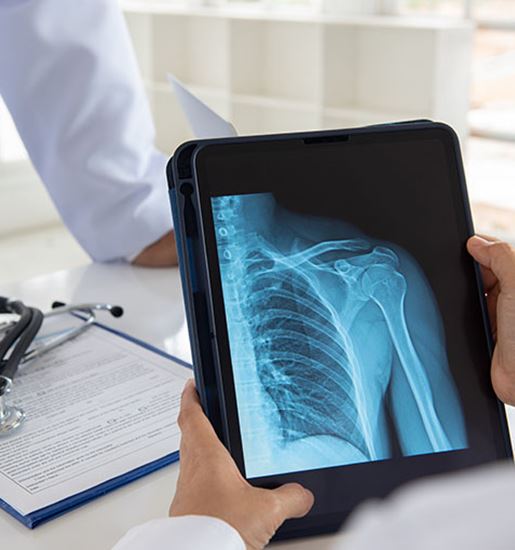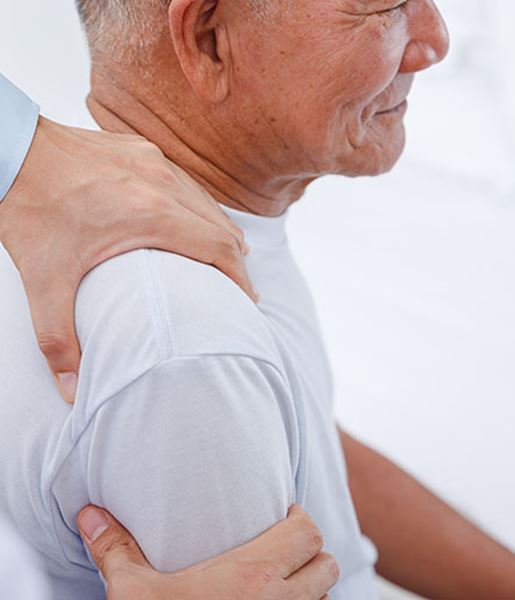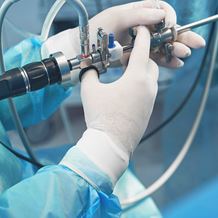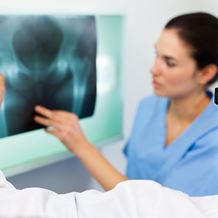Shoulder Replacement Surgery - Your Recovery
- Home
- Services
- Orthopaedics
- Knowledge Hub
- Shoulder Replacement Surgery – Your Recovery
Shoulder replacement surgery is a major operation, and success will look different for every patient. Taking an active role in your own recovery and following the home treatment plan as set out by your doctor, are crucial to regaining strength, mobility and health.
Rehabilitation plays a vital part in your recovery pathway. It helps you to regain confidence and independence, as well as helping you to take suitable precautions and avoid future injury. Our rehabilitation team includes physicians, physiotherapists, and occupational therapists, who will guide you each step of the way as you gradually regain your strength and return to daily activities.
Please ask about any inpatient or outpatient, individual and group rehabilitation sessions that you can access through your hospital.
You can learn more about the procedure for shoulder surgery in our shoulder replacement guide.

Home preparation after shoulder surgery
Before heading off to hospital, you can help ensure your home is well prepared for your return after surgery. This helps to avoid damage to your new shoulder joint and reduce the risk of further injury – particularly as your arm will be restricted by a sling. Allied Health will check your individual situation to ensure you have all the help you will need after surgery.
- Arrange for someone to collect you from hospital as you won’t be able to drive for a few weeks after surgery.
- Keep any essential items at an accessible height and within low reach to protect your new shoulder joint.
- Organise for some help with shopping and daily tasks for the first few weeks after surgery, until your mobility is cleared by your doctor.
- Stock up on pre-prepared meals and keep all cooking pots and utensils at counter height.
- Check your seating arrangements are at a suitable height, and stock up on some extra cushions for support if necessary.
- Consider your bathing arrangements and install a detachable shower head or shower chair to make movement easier.
- Ensure you have easy-wear items to hand such as front-opening shirts that won’t need lifting overhead.

Caring for your new shoulder
You can expect to feel some pain after surgery, but this is completely normal and should significantly reduce within six weeks. When you leave hospital, your arm will be in a sling for the next 2-6 weeks, depending on the extent of the surgery and the advice of your doctor. Limit any physical activity during the initial recovery period while your joint heals.
The swelling may take some time to fully go away and can be managed through regular ice packs and medication. The ice packs can be applied three times daily for 20 minutes each – remember to place a cloth between the icepack and your skin.
Keep your wound clean and dry until your medical team advises otherwise. Contact your doctor if you notice any new redness, swelling, stiffness or fever, as this could be a sign of infection.
Rehabilitation exercises
Before surgery
Your doctor may have recommended that you complete some daily exercises prior to surgery. Studies have shown that strengthening your muscles before your shoulder replacement surgery can help you to recover more quickly. Talk to your rehabilitation team about what you can do to help improve your recovery.
After surgery
Rehabilitation exercises play an essential role in your recovery and will begin shortly after surgery. You will be prescribed a specific set of exercises as part of your rehabilitation program, which are designed to strengthen your muscles, improve function and increase your range of motion.
The first stage of rehabilitation is about gentle exercises that will protect your joint and allow it to heal, while preventing any stiffness or swelling. The second stage will focus on a progression of exercises that challenge your arm to move through the stiff range. Once this has been achieved, the third stage centres on building up strength and re-engaging your joint so that you can achieve everyday tasks. The final stage of recovery is about restoring full function, which includes more strenuous tasks and activities. This is often the longest stage, and a full recovery can take up to one year. Our rehabilitation team includes physicians, physiotherapists and occupational therapists who will work with you at every stage as you gradually return to full strength.

Average recovery timeline
Weeks 1-6
Goal: Protect the shoulder joint, aid healing and prevent stiffness
- Keep your arm in the sling for the majority of time to prevent injury
- When your arm is out the sling, let your arm hang down and keep your elbow tucked into your side
- Do not rotate the shoulder away from the body
- Maintain your prescribed gentle exercise program, pausing if the pain exceeds mild discomfort
- Regular icing will help with any pain or swelling
Weeks 6+
Goal: Protect the shoulder joint, restore range of motion and stability
- The sling need only now be worn in public or in crowded areas
- Use your operated arm, but avoid any heavy lifting or manual labour
- Your exercises will now focus on loading the shoulder muscles to improve strength and mobility
- Driving may be permitted only on your doctor’s advice
Weeks 10-12
Goal: Protect the shoulder joint, regain full range of motion, and restore shoulder strength
- Home exercises continue to build strength and improve mobility
- Avoid any heavy lifting or sudden movements which can damage the joint
- The basic shoulder function with pain-free movement is likely to be restored within 12 weeks
Beyond 3 months
Maintaining your home exercise program is crucial to making a successful recovery. Talk to your doctor about returning to more vigorous activities such as golf, swimming, and tennis. A full recovery may take up to one year.
Shoulder precautions – what to avoid
Returning to everyday activities takes time and patience. Your doctor may make certain suggestions to help your recovery.
- Wear a sling – this will help protect your joint from external injury while it heals
- Don’t rotate your arm away from your body without clearance from your doctor
- Avoid any heavy lifting or pulling
- Don’t reach overhead, raise your arms up high or reach behind yourself
- Avoid driving until your doctor has cleared you do to so as this can cause dislocation
- Don’t rush your recovery – additional stress will increase your chance of injury
Frequently Asked Questions
How long will I have to wear a sling?
The sling must be worn at all times in the first instance as it helps to protect your shoulder joint while it heals. After the first 4-6 weeks, your doctor may suggest only wearing it during the day. After this time the sling need only be worn in public and crowded situations where your shoulder joint may get bumped or pushed.
When can I return to work?
If your job is desk-based and sedentary, you can usually return to work within 1-2 weeks. It will take between 3-6 months to return to physical jobs that require manual labour.
When can I play golf again?
Your doctor will advise as to when you can hit the course again, but typically this is not before 12-weeks after surgery. It can take up to another 6 months to get back to your former level. Adhering to the rehabilitation program and keeping up the exercises is the best way to get back to the golfing green.
When can I drive again?
Driving is not advised for the first 6 weeks after surgery, and not while the sling is still being worn as any sudden movement can damage the joint. The shoulder joint is vulnerable to re-injury and should not be moved away from the body.
This article contains information of a general nature, which may not be relevant to you. You should not rely on this article as medical advice. Any surgical or invasive procedure carries risk. We encourage you to speak with your doctor about your condition.
Related Content

Shoulder Replacement Surgery – Day of Surgery
What to expect on the day of shoulder surgery.
Read More
Shoulder Orthopaedics
The shoulder is the most flexible joint in the body. It allows us an incredible range of motion.
Read More
Find a Specialist
Talk to our world-leading orthopaedic specialists about the most suitable treatment options.
Read More